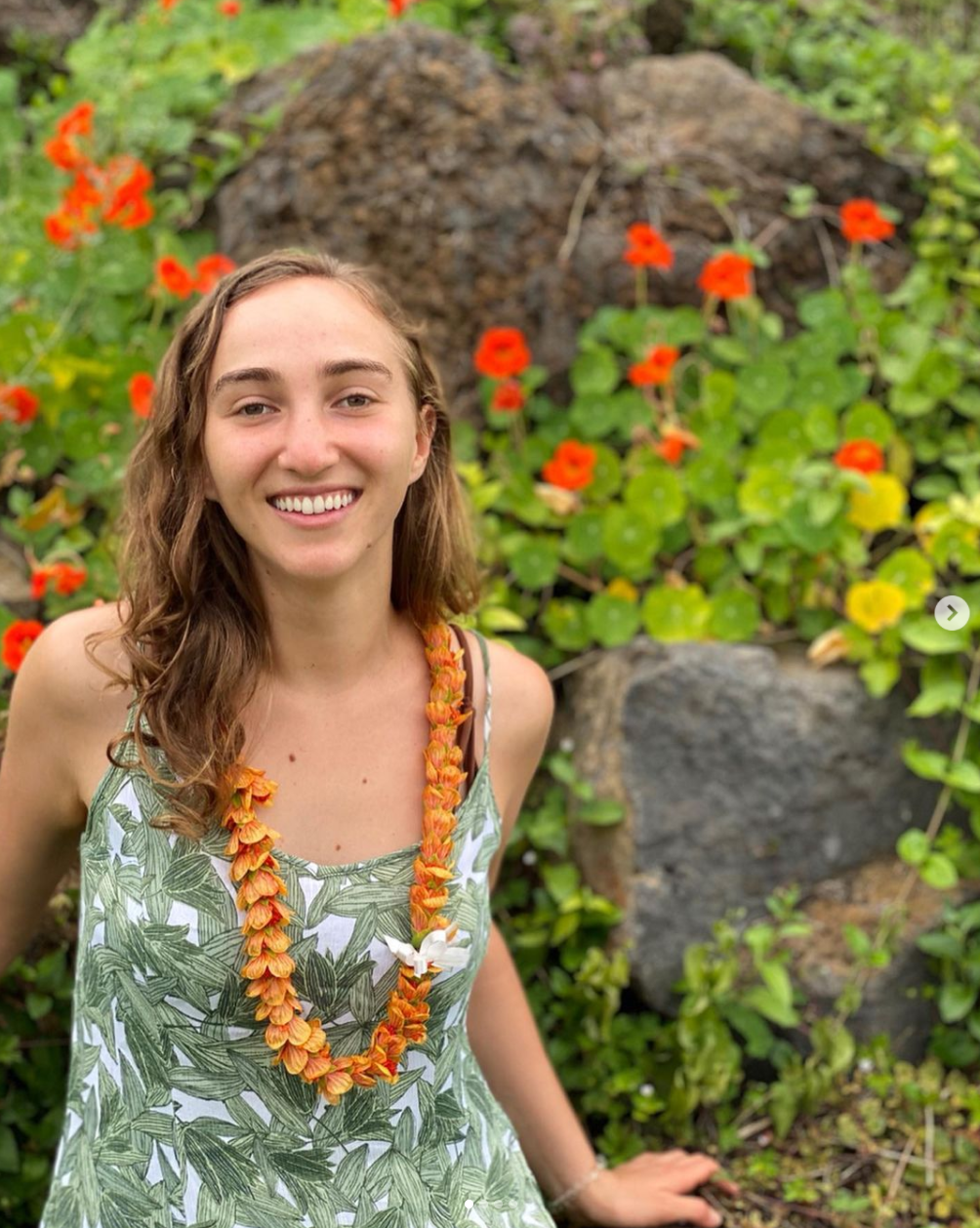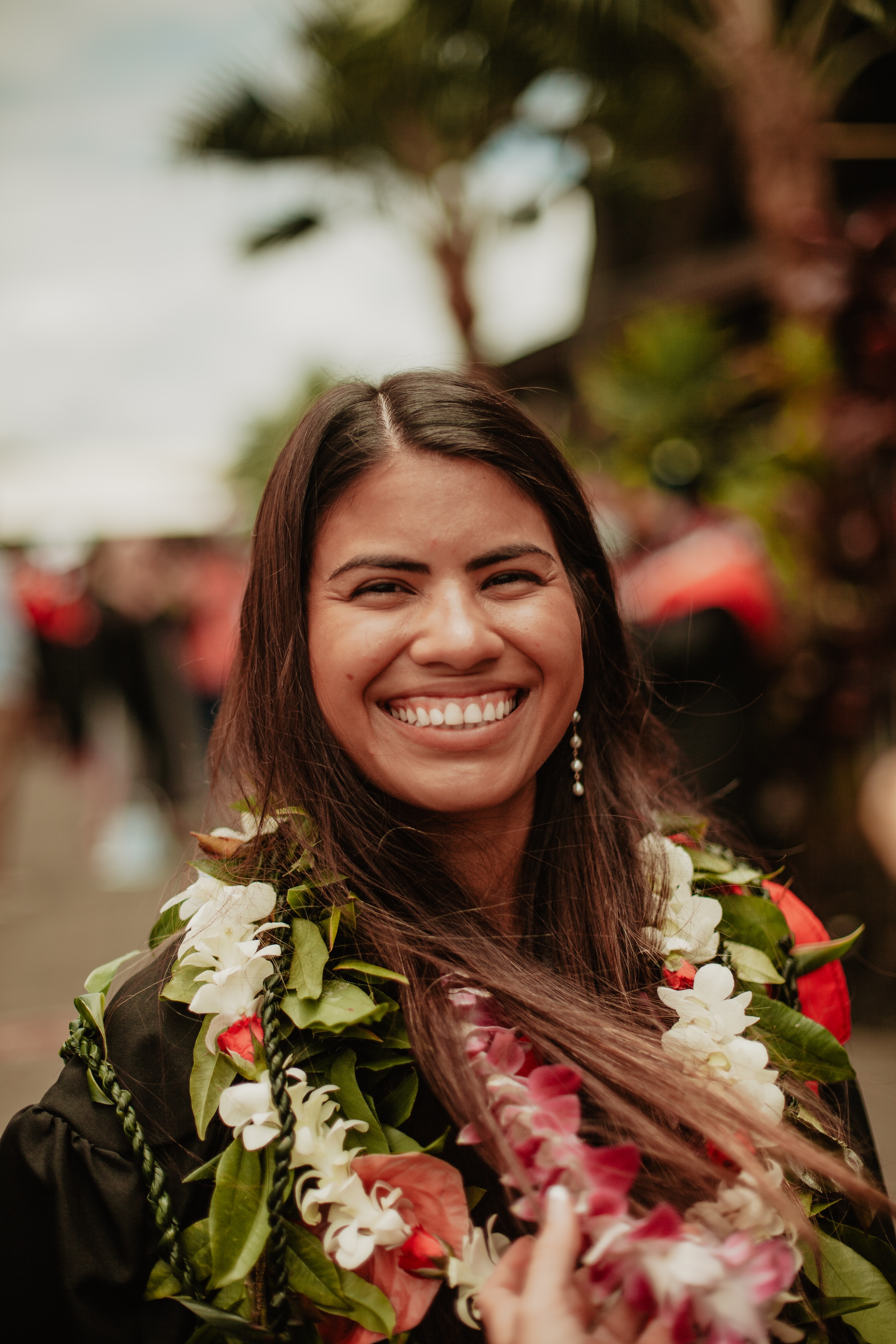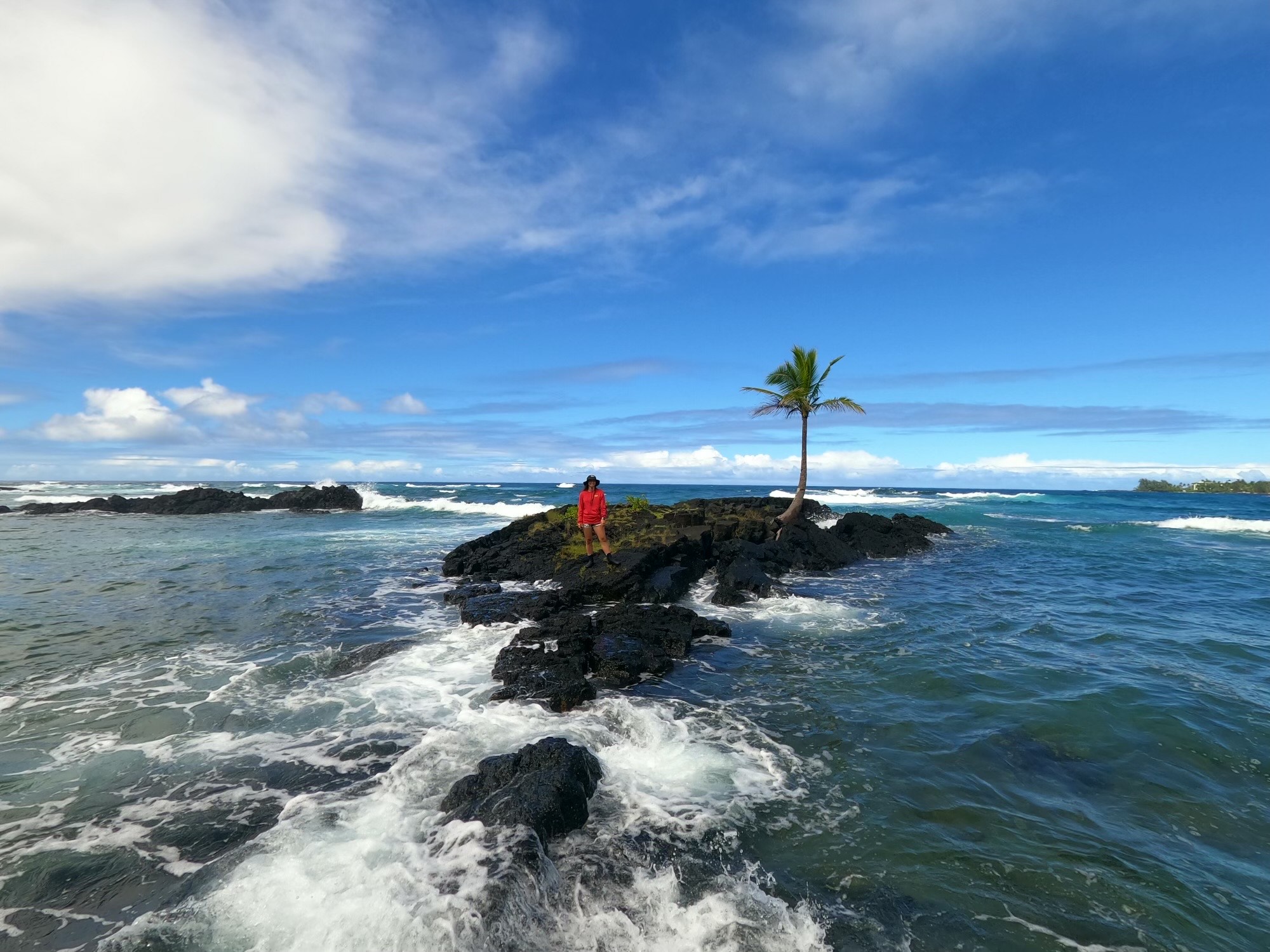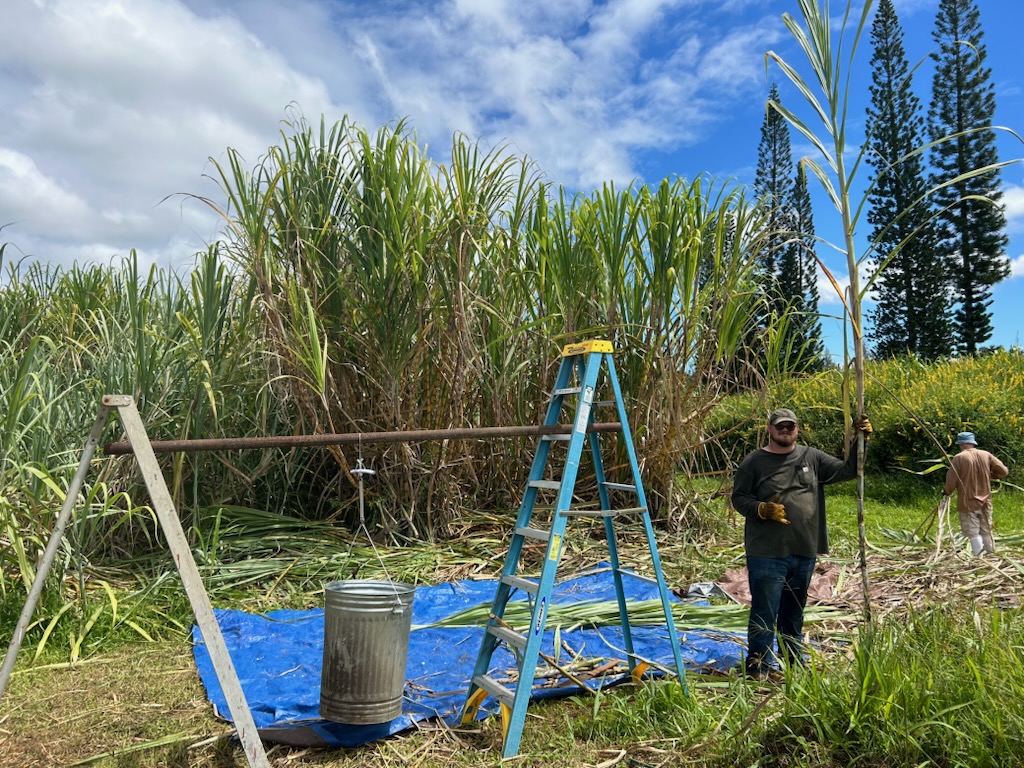2022 Thesis Cohort
On this page:
Christian Colo
 Christian is originally from Cleveland, Ohio but now lives in the Big Island. His thesis will examine nutrient fluxes out of the Wailuku River in the Hilo watershed and how this nutrient delivery may change under future climatic conditions. As the largest watershed in the state, the Hilo watershed delivers large amounts of nitrogen and phosphorus into the islandʻs coastal ecosystem, and these nutrients can fundamentally alter the downstream food webs. Establishing a baseline of these nutrient fluxes, determining their land-based sources, and predicting their future changes will be critical components in managing the coastal zone in an era of rapid change. His favorite parts of the thesis process are learning about the interconnectivity of the land and sea and working with people who are dedicated to environmental research and conservation. The most challenging part is understanding all the complex biogeochemical processes that make the world go round.
Christian is originally from Cleveland, Ohio but now lives in the Big Island. His thesis will examine nutrient fluxes out of the Wailuku River in the Hilo watershed and how this nutrient delivery may change under future climatic conditions. As the largest watershed in the state, the Hilo watershed delivers large amounts of nitrogen and phosphorus into the islandʻs coastal ecosystem, and these nutrients can fundamentally alter the downstream food webs. Establishing a baseline of these nutrient fluxes, determining their land-based sources, and predicting their future changes will be critical components in managing the coastal zone in an era of rapid change. His favorite parts of the thesis process are learning about the interconnectivity of the land and sea and working with people who are dedicated to environmental research and conservation. The most challenging part is understanding all the complex biogeochemical processes that make the world go round.
Konapiliahi Dancil
 Konapiliahi is from Makawao, Maui. His thesis is on restoration species selection for lowland wet forests on Hawai‘i Island. He also works with the Liko Na Pilina Hybrid Restoration Ecosystems project tackling restoration treatment types as the Field Research Technician. The project tests functional theory of plant community assemblages to assess invasion resistance and native species persistence using species that are native, Polynesian introduced, and exotic. His favorite part of his thesis experience has been meeting with professionals around the island that have been in this field for decades who are both inspiring and extremely educational. The most challenging part has been drafting and completing his proposal. A not-so-fun fact he gave is that nearly all of Hawai‘i's lowland wet forests on the Big Island of Hawai‘i are heavily invaded by invasive species. At this point in time, arguably no historically pristine lowland wet forests are present and new highly invaded systems are drastically changing each year with more invasive species continuing to dominate and decimate the few native plant populations persisting.
Konapiliahi is from Makawao, Maui. His thesis is on restoration species selection for lowland wet forests on Hawai‘i Island. He also works with the Liko Na Pilina Hybrid Restoration Ecosystems project tackling restoration treatment types as the Field Research Technician. The project tests functional theory of plant community assemblages to assess invasion resistance and native species persistence using species that are native, Polynesian introduced, and exotic. His favorite part of his thesis experience has been meeting with professionals around the island that have been in this field for decades who are both inspiring and extremely educational. The most challenging part has been drafting and completing his proposal. A not-so-fun fact he gave is that nearly all of Hawai‘i's lowland wet forests on the Big Island of Hawai‘i are heavily invaded by invasive species. At this point in time, arguably no historically pristine lowland wet forests are present and new highly invaded systems are drastically changing each year with more invasive species continuing to dominate and decimate the few native plant populations persisting.
Anna Ezzy

Sofia Ferreira Colman

Olivia Jarvis
 Olivia is from Oceanside, California. For her thesis, she is mapping strawberry guava tree populations identified in aerial imagery using machine learning in ‘Ōla‘a Forest in Hawai'i Volcanoes National Park and ‘Ōla‘a Forest Reserve. She is also creating a machine learning model to detect and monitor the spread of biocontrol releases for strawberry guava. She works in the Spatial Data Analysis and Visualization (SDAV) lab and has had the opportunity to help collect GPS data to map Hawai'i County's shoreline, go in the helicopter to collect aerial imagery of an ʻōhiʻa forest to map Rapid ʻŌhiʻa Death (ROD), assist in the release and monitoring of biocontrol for strawberry guava trees, and attend and present a poster at the International Congress on Biological Invasions conference in Aotearoa New Zealand. Through the TCBES program, she has also worked on fun group projects, volunteered in loko i'a, outplanted native trees in forest reserves, and has gotten to know her really awesome cohort. She has really enjoyed learning more about conservation and relationships in different environments in Hawai'i. The most challenging thing she has done for her thesis was narrow her interests into a reasonable Master's project with good research questions and write a proposal for how she is going to accomplish it. A fun fact she gave about her work is that the biocontrol used to reduce the spread of invasive strawberry guava trees is a leaf galling insect (Tectococcus ovatus) that creates some gnarly growths on the leaves to stunt tree growth.
Olivia is from Oceanside, California. For her thesis, she is mapping strawberry guava tree populations identified in aerial imagery using machine learning in ‘Ōla‘a Forest in Hawai'i Volcanoes National Park and ‘Ōla‘a Forest Reserve. She is also creating a machine learning model to detect and monitor the spread of biocontrol releases for strawberry guava. She works in the Spatial Data Analysis and Visualization (SDAV) lab and has had the opportunity to help collect GPS data to map Hawai'i County's shoreline, go in the helicopter to collect aerial imagery of an ʻōhiʻa forest to map Rapid ʻŌhiʻa Death (ROD), assist in the release and monitoring of biocontrol for strawberry guava trees, and attend and present a poster at the International Congress on Biological Invasions conference in Aotearoa New Zealand. Through the TCBES program, she has also worked on fun group projects, volunteered in loko i'a, outplanted native trees in forest reserves, and has gotten to know her really awesome cohort. She has really enjoyed learning more about conservation and relationships in different environments in Hawai'i. The most challenging thing she has done for her thesis was narrow her interests into a reasonable Master's project with good research questions and write a proposal for how she is going to accomplish it. A fun fact she gave about her work is that the biocontrol used to reduce the spread of invasive strawberry guava trees is a leaf galling insect (Tectococcus ovatus) that creates some gnarly growths on the leaves to stunt tree growth.
Ihilani Kamau
 Ihilani is from Hilo, Hawaii. Her thesis focuses on predicting the impact of sea level rise on wastewater infrastructures and water quality in order to make adaptive plans to increase coastal habitat resilience. Her research is conducted throughout the moku of Kona from the Kailua pier to Keauhou Bay. She has enjoyed learning how to identify sewage pollution hotspots at the shoreline using different methods such as fecal indicator bacteria (FIB), collecting water samples (nutrients and isotopes), and conducting a δ15N analysis with the limu samples. Although this shoreline is located on the other side of the island from where she grew up this research was very meaningful for her because of how important it was for the local community. She enjoys having conversations with the community members, listening to all their stories about the areas, and being able to share with them what she has been working on. Although getting up and leaving Hilo at 4am was slightly challenging, it was always rewarding with a nice sunrise and a great sample collecting morning in Kona. One of the challenging parts of this project was trying to collect all of the samples from the 12 stations, driving back to Hilo, processing the samples, and placing it in the incubator within the 6 hour time frame. We always got it done and had fun doing it along the way. Her favorite part of this project was reading the bacteria on day 2 and seeing all of the results from the samples that we collected.
Ihilani is from Hilo, Hawaii. Her thesis focuses on predicting the impact of sea level rise on wastewater infrastructures and water quality in order to make adaptive plans to increase coastal habitat resilience. Her research is conducted throughout the moku of Kona from the Kailua pier to Keauhou Bay. She has enjoyed learning how to identify sewage pollution hotspots at the shoreline using different methods such as fecal indicator bacteria (FIB), collecting water samples (nutrients and isotopes), and conducting a δ15N analysis with the limu samples. Although this shoreline is located on the other side of the island from where she grew up this research was very meaningful for her because of how important it was for the local community. She enjoys having conversations with the community members, listening to all their stories about the areas, and being able to share with them what she has been working on. Although getting up and leaving Hilo at 4am was slightly challenging, it was always rewarding with a nice sunrise and a great sample collecting morning in Kona. One of the challenging parts of this project was trying to collect all of the samples from the 12 stations, driving back to Hilo, processing the samples, and placing it in the incubator within the 6 hour time frame. We always got it done and had fun doing it along the way. Her favorite part of this project was reading the bacteria on day 2 and seeing all of the results from the samples that we collected.
Brianna Ninomoto
 Brianna is from Kāneʻohe, Oʻahu. Her thesis is on the impacts of sea level rise on loko iʻa (Hawaiian fishponds) water quality and surrounding communities. All loko iʻa she is studying are within the ʻokana of Hilo Hanakahi in the ahupuaʻa of Wāiakea in the moku of Hilo. One area will be the Wailoa pond, which is a historical fishpond. Another area is within the ʻili kūpono of Honohononui. Thirdly, she will be studying the loko iʻa within the ʻili ʻāina of Kaumaui. For her thesis, she has been able to learn the protocols of how to fly a drone and make three-dimensional models with the drone imagery. In addition, she has shared the models with community and school groups who are familiar with areas in Keaukaha. Her favorite part of her thesis is being able to work with multiple organizations within Keaukaha that work towards promoting and educating others about the practice of fishponds. The most challenging part is that part of her data relies on leaving in-water sensors in areas accessible to the public. This increases the risk of having them being removed from the water. An interesting fact she gave about her work is that due to the development of the road in Keaukaha, many of the loko kiaʻi have had to modify how they are able to recruit pua (baby fish) from the ocean and balance the wai kai (brackish water) conditions.
Brianna is from Kāneʻohe, Oʻahu. Her thesis is on the impacts of sea level rise on loko iʻa (Hawaiian fishponds) water quality and surrounding communities. All loko iʻa she is studying are within the ʻokana of Hilo Hanakahi in the ahupuaʻa of Wāiakea in the moku of Hilo. One area will be the Wailoa pond, which is a historical fishpond. Another area is within the ʻili kūpono of Honohononui. Thirdly, she will be studying the loko iʻa within the ʻili ʻāina of Kaumaui. For her thesis, she has been able to learn the protocols of how to fly a drone and make three-dimensional models with the drone imagery. In addition, she has shared the models with community and school groups who are familiar with areas in Keaukaha. Her favorite part of her thesis is being able to work with multiple organizations within Keaukaha that work towards promoting and educating others about the practice of fishponds. The most challenging part is that part of her data relies on leaving in-water sensors in areas accessible to the public. This increases the risk of having them being removed from the water. An interesting fact she gave about her work is that due to the development of the road in Keaukaha, many of the loko kiaʻi have had to modify how they are able to recruit pua (baby fish) from the ocean and balance the wai kai (brackish water) conditions.
Naiʻa Odachi
 Nai‘a grew up right here in Hawai‘i. Her thesis focuses on using high-resolution satellite imagery as an alternative method for detection and monitoring of Rapid ‘Ōhi‘a Death (ROD) in Hawai‘i. She will be creating a time series analysis of annual mortality identified in satellite imagery and train an automated identification program that can be used to identify new ROD outbreaks on Hawai'i as well as other islands. Her research focuses on East Hawai'i Island, but she will be testing automated identification of Rapid 'Ōhi'a Death suspect trees on other islands as well. She was able to present her research at the International Congress on Biological Invasions in Ōtautahi Christchurch, Aotearoa New Zealand as well as at the Hawai'i Conservation Conference in Honolulu, Hawai'i. Her favorite part of her thesis is being able to contribute to a larger field of research and address an issue that is of great concern to the Hawai'i community. The most challenging part of her research is how quickly visual ROD symptoms progress. When mortality data is collected, variations by months or weeks can skew comparisons and time lags between suspect identification and ROD sampling can potentially result in false negatives.
Nai‘a grew up right here in Hawai‘i. Her thesis focuses on using high-resolution satellite imagery as an alternative method for detection and monitoring of Rapid ‘Ōhi‘a Death (ROD) in Hawai‘i. She will be creating a time series analysis of annual mortality identified in satellite imagery and train an automated identification program that can be used to identify new ROD outbreaks on Hawai'i as well as other islands. Her research focuses on East Hawai'i Island, but she will be testing automated identification of Rapid 'Ōhi'a Death suspect trees on other islands as well. She was able to present her research at the International Congress on Biological Invasions in Ōtautahi Christchurch, Aotearoa New Zealand as well as at the Hawai'i Conservation Conference in Honolulu, Hawai'i. Her favorite part of her thesis is being able to contribute to a larger field of research and address an issue that is of great concern to the Hawai'i community. The most challenging part of her research is how quickly visual ROD symptoms progress. When mortality data is collected, variations by months or weeks can skew comparisons and time lags between suspect identification and ROD sampling can potentially result in false negatives.
Brian Rule
 Brian is from Meade County, Kentucky. His thesis is about the Agronomic impacts of split fertilizer regime and harvest intervals on Hawaiian energy cane cultivars. This project is the groundwork for a future industry in sustainable aviation fuel made from energy cane. The research is being conducted in Panaewa at the UH research farm. His favorite part of this project was learning the multitude of different products that can come from one crop, like sugar juice, biofuel, and bioplastics. The most challenging part of this project has been balancing fieldwork with class and lab work.
Brian is from Meade County, Kentucky. His thesis is about the Agronomic impacts of split fertilizer regime and harvest intervals on Hawaiian energy cane cultivars. This project is the groundwork for a future industry in sustainable aviation fuel made from energy cane. The research is being conducted in Panaewa at the UH research farm. His favorite part of this project was learning the multitude of different products that can come from one crop, like sugar juice, biofuel, and bioplastics. The most challenging part of this project has been balancing fieldwork with class and lab work.
Kalena Shiroma
 Kalena is from Olaʻa and Kaʻūmana, Hawaiʻi. Her interests from her undergraduate have shifted greatly from agriculture and plant pathology to insect biodiversity, to finally forestry and geography in her current work. Prior to attending graduate school, she spent the last 3 years as a forestry technician for the USDA Forest Service Forest Inventory and Analysis (FIA) Program, gathering data on forests throughout the main Hawaiian Islands. Her work connecting with the native ecosystems inspired her to study forests from a new perspective. Her thesis is focused on creating orthoimages of Hawaiʻi forests using Small Unoccupied Aerial Systems (sUAS) in combination with Structure from Motion (SfM) photogrammetry. These orthoimages will be compared to on-ground field measurements to test the efficacy of forest assessments on a plot level. Her study site is in Puʻu Waʻawaʻa, with an addition of another study site with steep slopes on Big Island and hopes to measure hazardous cliff ecosystems with sUAS. Her favorite things about her graduate career include learning more within her thesis-driven discipline but also about research that her mentors and student peers are conducting, as well as volunteering for events and efforts which aim to preserve native ecosystems. The most challenging past of her thesis work is writing and applying for research permits, but grateful to experience the process.
Kalena is from Olaʻa and Kaʻūmana, Hawaiʻi. Her interests from her undergraduate have shifted greatly from agriculture and plant pathology to insect biodiversity, to finally forestry and geography in her current work. Prior to attending graduate school, she spent the last 3 years as a forestry technician for the USDA Forest Service Forest Inventory and Analysis (FIA) Program, gathering data on forests throughout the main Hawaiian Islands. Her work connecting with the native ecosystems inspired her to study forests from a new perspective. Her thesis is focused on creating orthoimages of Hawaiʻi forests using Small Unoccupied Aerial Systems (sUAS) in combination with Structure from Motion (SfM) photogrammetry. These orthoimages will be compared to on-ground field measurements to test the efficacy of forest assessments on a plot level. Her study site is in Puʻu Waʻawaʻa, with an addition of another study site with steep slopes on Big Island and hopes to measure hazardous cliff ecosystems with sUAS. Her favorite things about her graduate career include learning more within her thesis-driven discipline but also about research that her mentors and student peers are conducting, as well as volunteering for events and efforts which aim to preserve native ecosystems. The most challenging past of her thesis work is writing and applying for research permits, but grateful to experience the process.
Josephine Tupu
 Josie is from Samoa. Her thesis is about using bioacoustic technology to study native Hawaiian birds at Hakalau Forest NWR. Besides her thesis research, Iʻm helping continue the mosquito monitoring project and data collection for the seed rain project at HFNWR. Over the summer, she co-mentored a PIPES intern for a study on establishing an ʻŌhiʻa forest for native birds at Kanakaleonui Bird Corridor. She is also part of the Kaiameaola club and vice president (2023-2024). Outside of school work, she volunteers for conservation programs on Hawaiʻi Island, learning about native species and building relationships with places and people. Her favorite part about my thesis experience is spending time in Hakalau forest, seeing and hearing native birds singing from all corners of the forest, and also learning about different native plants.
Josie is from Samoa. Her thesis is about using bioacoustic technology to study native Hawaiian birds at Hakalau Forest NWR. Besides her thesis research, Iʻm helping continue the mosquito monitoring project and data collection for the seed rain project at HFNWR. Over the summer, she co-mentored a PIPES intern for a study on establishing an ʻŌhiʻa forest for native birds at Kanakaleonui Bird Corridor. She is also part of the Kaiameaola club and vice president (2023-2024). Outside of school work, she volunteers for conservation programs on Hawaiʻi Island, learning about native species and building relationships with places and people. Her favorite part about my thesis experience is spending time in Hakalau forest, seeing and hearing native birds singing from all corners of the forest, and also learning about different native plants.
